

It is a general rule of Bible interpretation that one uses
scripture to interpret scripture. The books of the Bible are always
consistent with each other. The meaning of symbols does not change
from Genesis through Revelation. God's revelation of Himself (and
about everything else as well) is progressive down through history.
There is no one book of the Bible that tells us all we want to
know about a subject (such as creation). We must first study the
whole Bible and then we can look at various subjects and gain
a good understanding.
The well known "Golden Rule of Interpretation" states: "When the plain sense of Scripture
makes common sense, seek no other sense; therefore, take every word at its primary,
ordinary, usual, literal meaning unless the facts of the immediate context, studied in the light of related passages and axiomatic and fundamental truths, indicate clearly otherwise."
|
|
| 1:1 In the beginning God created the heavens and the earth. 2 (And) The earth was without form, and void; and darkness [was] on the face of the deep. And the Spirit of God was hovering over the face of the waters. 3 (And) Then God said, "Let there be light"; and there was light. 4 And God saw the light, that it was good; and God divided the light from the darkness. 5 God called the light Day, and the darkness He called Night. (And) So the evening and the morning were the first day. 6 (And) Then God said, "Let there be a firmament in the midst of the waters, and let it divide the waters from the waters." 7 (And) Thus God made the firmament, and divided the waters which were under the firmament from the waters which were above the firmament; and it was so. 8 And God called the firmament Heaven. (And) So the evening and the morning were the second day. 9 (And) Then God said, "Let the waters under the heavens be gathered together into one place, and let the dry land appear"; and it was so. 10 And God called the dry [land] Earth, and the gathering together of the waters He called Seas. And God saw that it was good. 11 (And) Then God said, "Let the earth bring forth grass, the herb that yields seed, and the fruit tree that yields fruit according to its kind, whose seed is in itself, on the earth"; and it was so. 12 And the earth brought forth grass, the herb that yields seed according to its kind, and the tree that yields fruit, whose seed is in itself according to its kind. And God saw that it was good. 13 (And) So the evening and the morning were the third day. 14 (And) Then God said, "Let there be lights in the firmament of the heavens to divide the day from the night; and let them be for signs and seasons, and for days and years; 15 and let them be for lights in the firmament of the heavens to give light on the earth"; 16 (And) Then God made two great lights: the greater light to rule the day, and the lesser light to rule the night. He made the stars also. 17 (And) God set them in the firmament of the heavens to give light on the earth, 18 and to rule over the day and over the night, and to divide the light from the darkness. And God saw that it was good 19 (And) So the evening and the morning were the fourth day. 20 (And) Then God said, "Let the waters abound with an abundance of living creatures, and let birds fly above the earth across the face of the firmament of the heavens." 21 (And) So God created great sea creatures and every living thing that moves, with which the waters abounded, according to their kind, and every winged bird according to its kind. And God saw that it was good. 22 And God blessed them, saying, "Be fruitful and multiply, and fill the waters in the seas, and let birds multiply on the earth." 23 (And) So the evening and the morning were the fifth day. 24 (And) Then God said, "Let the earth bring forth the living creature according to its kind: cattle and creeping thing and beast of the earth, each according to its kind"; and it was so. 25 And God made the beast of the earth according to its kind, cattle according to its kind, and everything that creeps on the earth according to its kind. And God saw that it was good. 26 (And) Then God said, "Let Us make man in Our image, according to Our likeness; (and) let them have dominion over the fish of the sea, over the birds of the air, and over the cattle, over all the earth and over every creeping thing that creeps on the earth." 27 (And) So God created man in His own image; in the image of God He created him; male and female He created them. 28 (And) Then God blessed them, and God said to them, "Be fruitful and multiply; fill the earth and subdue it; have dominion over the fish of the sea, over the birds of the air, and over every living thing that moves on the earth." 29 And God said, "See, I have given you every herb that yields seed which is on the face of all the earth, and every tree whose fruit yields seed; to you it shall be for food. 30 (And) Also, to every beast of the earth, to every bird of the air, and to everything that creeps on the earth, in which there is life, I have given every green herb for food"; and it was so. 31 (And) Then God saw everything that He had made, and indeed it was very good. So the evening and the morning were the sixth day. 2:1 (And) Thus the heavens and the earth, and all the host of them, were finished. 2 And on the seventh day God ended His work which He had done, and He rested on the seventh day from all His work which He had done. 3 (And) Then God blessed the seventh day and sanctified it, because in it He rested from all His work which God had created and made. 4 This [is] the history of the heavens and the earth when they were created... |
In contrast with this Biblical order of events, the Big Bang model
hypothesizes that the universe began with a burst of light. Matter
followed afterwards after the fireball cooled. But in Genesis
1, the creation of light seems to have been the second
of God's creative acts, not the first. Recent observations strongly suggest that the Big Bang Never Happened.
Secular cosmology estimates the number of protons in the universe
as approximately 1080--whereas the number of photons
in the universe appears to be about 9 orders of magnitude greater
than the number of protons. (Ref. 1) At first, the light created
on Day One was apparently not concentrated into the stars, since
this occurred on Day Four. The residual background radiation of
space described in the Big Bang Model as the residual energy from
the original fireball may instead be the left-over light energy
from God's separate creative act of calling energy into existence.
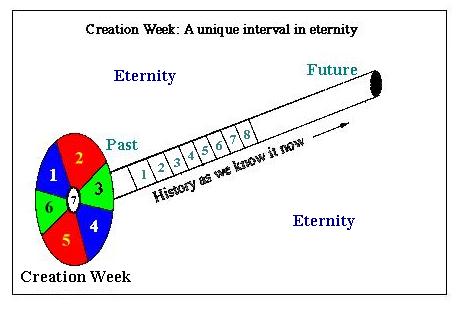 At the end of Day One space, time, matter, and energy had been
brought into existence as amorphous raw materials out of which
a finished universe would be sculpted and formed during the five
days which were to follow. The ancient Greeks thought the four
building blocks of the universe were air, earth, fire and water.
Four is the Biblical number for the world---the Greeks weren't
too far from being on the right track if we compare air/space,
fire/energy, and earth/matter. They missed the "element"
of time as a building material for the construction of the universe.
At the end of Day One space, time, matter, and energy had been
brought into existence as amorphous raw materials out of which
a finished universe would be sculpted and formed during the five
days which were to follow. The ancient Greeks thought the four
building blocks of the universe were air, earth, fire and water.
Four is the Biblical number for the world---the Greeks weren't
too far from being on the right track if we compare air/space,
fire/energy, and earth/matter. They missed the "element"
of time as a building material for the construction of the universe.
Prior to this creative activity of God none of these entities
existed. However God, who is Spirit, existed. In fact He has always
existed and His existence is independent of time and space, and
also of all created things. It was not necessary for God
to create a universe. God is complete and whole in His own Being
and the existence of a universe with all its life-forms and awesome
extent adds nothing to God.
Although God is One God, He exists in three Persons. This we know
from God's own self-revelation of Himself to us as recorded in
the Bible. The Persons of the Godhead work together in Creation
as they do in the sustenance and management of the universe, in
the redemption of men, in judgment, and in the creation of the
new world which is to come. The God of the Bible is a "personal"
God. He is a living, intelligent, loving being and has created
us capable of relationships with Him and with one another. 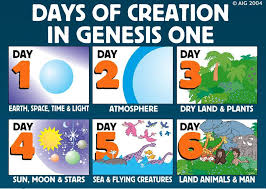 The Bible emphasizes that the universe was created in six days.
"for in six days the LORD made heaven and earth, the sea,
and all that is in them, and rested the seventh day; therefore
the LORD blessed the sabbath day and hallowed it. " (Exodus
20:11) The Hebrew word for an ordinary 24-hour day, yom, is
used. Endless and often futile debates have raged over whether
or not the seven days of Creation Week were literal 24-hour days
or long periods of time.
The Bible emphasizes that the universe was created in six days.
"for in six days the LORD made heaven and earth, the sea,
and all that is in them, and rested the seventh day; therefore
the LORD blessed the sabbath day and hallowed it. " (Exodus
20:11) The Hebrew word for an ordinary 24-hour day, yom, is
used. Endless and often futile debates have raged over whether
or not the seven days of Creation Week were literal 24-hour days
or long periods of time.
Part of the problem in understanding creation week is that this
interval of time---when God was in the process of creating everything---was
truly unique and never to be repeated. I have attempted to depict
this situation by the following diagram. The time frame we live
in now is represented by the broad line extending to the right,
but I have shown creation week as a wheel or disk at right angles.
"Eternity past"---when there was no universe at all, lies to the left of the colored disc. Genesis One (since it is recording truth in logos format) describes
the order of creation as Day 1, followed by Day 2, 3, 4, 5, 6,
and finally 7. After that man's history begins. However I have
color-coded Days 1 and 4, Days 2 and 5 and Days 3 and 6 to show
that they bear a relationship to each other (as will be described
a bit later). God is outside of time, so while constructing the
universe He could actually have worked on all six days at once,
or built them separately as modules and put them together into
one pie all at the end.
There is an "observer" present in the narrative of Genesis One, and the observer appears to be standing on the Earth as his observation platform, but the observer is clearly God Himself in Genesis Chapter One. In Jewish rabbinical legends, while creating the universe God is said to have stood on the "Foundation Stone" which would later be under the Holy of Holies of the Temples in Jerusalem. See Absolute Geocentricity.
The following table shows the many action verbs in Genesis Chapter One. Creation was not a single event, but a series of events. It was a complex process taking place over a period of time encompassing, as we are told, six ordinary 24-hour days--that is "creation in 144 hours."
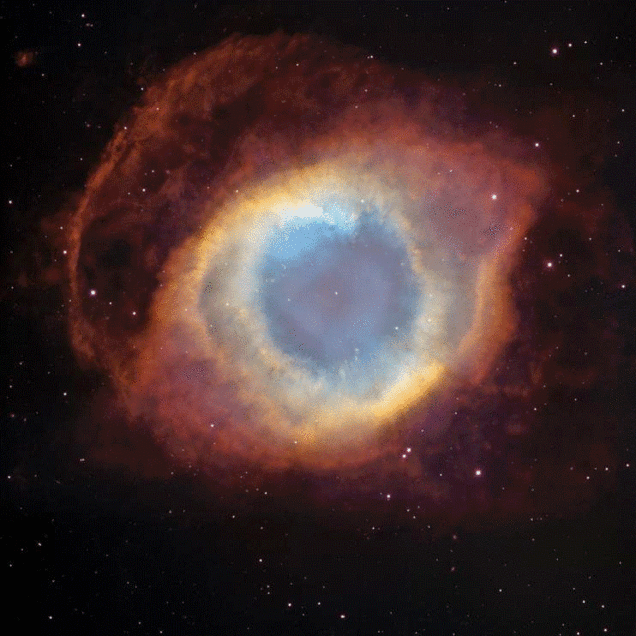
|
|
|
In the beginning God created the heavens and the earth. 2 The earth was without form and void, and darkness was upon the face of the deep; and the Spirit of God was moving over the face of the waters. 3 And God said, "Let there be light"; and there was light. 4 And God saw that the light was good; and God separated the light from the darkness. 5 God called the light Day, and the darkness he called Night. And there was evening and there was morning, one day. 6 And God said, "Let there be a firmament in the midst of the waters, and let it separate the waters from the waters." 7 And God made the firmament and separated the waters which were under the firmament from the waters which were above the firmament. And it was so. 8 And God called the firmament Heaven. And there was evening and there was morning, a second day. 9 And God said, "Let the waters under the heavens be gathered together into one place, and let the dry land appear." And it was so. 10 God called the dry land Earth, and the waters that were gathered together he called Seas. And God saw that it was good. 11 And God said, "Let the earth put forth vegetation, plants yielding seed, and fruit trees bearing fruit in which is their seed, each according to its kind, upon the earth." And it was so. 12 The earth brought forth vegetation, plants yielding seed according to their own kinds, and trees bearing fruit in which is their seed, each according to its kind. And God saw that it was good. 13 And there was evening and there was morning, a third day. 14 And God said, "Let there be lights in the firmament of the heavens to separate the day from the night; and let them be for signs and for seasons and for days and years, 15 and let them be lights in the firmament of the heavens to give light upon the earth." And it was so. 16 And God made the two great lights, the greater light to rule the day, and the lesser light to rule the night; he made the stars also. 17 And God set them in the firmament of the heavens to give light upon the earth, 18 to rule over the day and over the night, and to separate the light from the darkness. And God saw that it was good. 19 And there was evening and there was morning, a fourth day. 20 And God said, "Let the waters bring forth swarms of living creatures, and let birds fly above the earth across the firmament of the heavens." 21 So God created the great sea monsters and every living creature that moves, with which the waters swarm, according to their kinds, and every winged bird according to its kind. And God saw that it was good. 22 And God blessed them, saying, "Be fruitful and multiply and fill the waters in the seas, and let birds multiply on the earth." 23 And there was evening and there was morning, a fifth day. 24 And God said, "Let the earth bring forth living creatures according to their kinds: cattle and creeping things and beasts of the earth according to their kinds." And it was so. 25 And God made the beasts of the earth according to their kinds and the cattle according to their kinds, and everything that creeps upon the ground according to its kind. And God saw that it was good. 26 Then God said, "Let us make man in our image, after our likeness; and let them have dominion over the fish of the sea, and over the birds of the air, and over the cattle, and over all the earth, and over every creeping thing that creeps upon the earth." 27 So God created man in his own image, in the image of God he created him; male and female he created them. 28 And God blessed them, and God said to them, "Be fruitful and multiply, and fill the earth and subdue it; and have dominion over the fish of the sea and over the birds of the air and over every living thing that moves upon the earth." 29 And God said, "Behold, I have given you every plant yielding seed which is upon the face of all the earth, and every tree with seed in its fruit; you shall have them for food. 30 And to every beast of the earth, and to every bird of the air, and to everything that creeps on the earth, everything that has the breath of life, I have given every green plant for food." And it was so. 31 And God saw everything that he had made, and behold, it was very good. And there was evening and there was morning, a sixth day. 2:1 Thus the heavens and the earth were finished, and all the host of them. 2 And on the seventh day God finished his work which he had done, and he rested on the seventh day from all his work which he had done. 3 So God blessed the seventh day and hallowed it, because on it God rested from all his work which he had done in creation. 4a These are the generations of the heavens and the earth when they were created. In this passage: God is called "He" 10 times God said, 10 times "I Have Given" occurs twice God created, 6 times God made, 5 times God saw, 7 times "Let There Be", 15 times (God) rested, 2 times (God) finished, 2 times Spirit moving, once "And it was so," 6 times Called "good" 6 times and "very good" once |
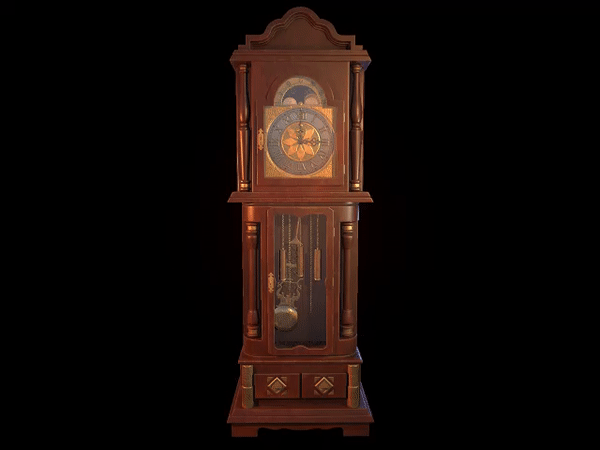


Clocks and watches driven by quartz crystals and battery powered have run rates determined by basic physical, mechanical laws. Clocks of this kind also measure what has been called "dynamical time." In contrast atomic clocks are dependent upon rates of radioactive decay, by the interval between atomic transitions, by the spectral wavelength of emitted photons, etc. But atomic clocks are not necessarily running in lock-step with mechanical clocks.
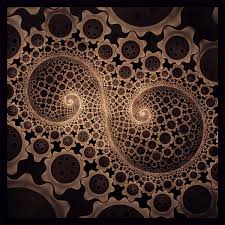 The calendars and clocks used in the Bible for recording historical
events are all based on the dynamical time system:
The calendars and clocks used in the Bible for recording historical
events are all based on the dynamical time system:
And God said, "Let there be lights in the firmament of
the heavens to separate the day from the night; and let them
be for [measuring] signs and for seasons and for days and years,
and let them be lights in the firmament of the heavens to give
light upon the earth." And it was so. And God made the two
great lights, the greater light to rule the day, and the lesser
light to rule the night; he made the stars also. And God set
them in the firmament of the heavens to give light upon the earth,
to rule over the day and over the night, and to separate the
light from the darkness. And God saw that it was good. And there
was evening and there was morning, a fourth day. (Genesis 1:14-19)
To return to the analogy of the pendulum clock, once the clockmaker
has designed the clock and built the parts the run rate of the
clock has been forever determined. But only after the clock has
been assembled and started will it "keep time." As far
as the clock parts are concerned, the time-keeping history of
the clock begins when the clock starts ticking, not when the component
parts are manufactured.
Although God's "wristwatch" recorded cycles of what
would later be 24-hour days while He was creating the universe,
time as we know it now was not defined during creation week---at least by the standards
we now use to measure time. This is because the universe is in
fact a UNI-verse and all its parts and pieces are interlinked
and interdependent. Only when all the universe was completed could
the planets run properly in their appointed courses and the atomic
particles begin their interactions with one another, within and
around the nucleus. We can not take time as we experience it now
and extrapolate it backwards in history all the way to Day One
of creation week. We can, with confidence talk about historical
events and their time sequence beginning with Adam's exit from
the Garden. This later approach is more that sufficient to establish
a universe which was only recently created. Adam One and Adam
Two (Jesus Christ) are clearly linked in the Old Testament by
a clear line of genealogical ties. The maximum time frame between
the Two Adams is clearly only a few thousand years. See also, Absolute Geocentricity.

"Six days you shall labor, and do all your work; but the seventh day is a sabbath to the LORD your God; in it you shall not do any work, you, or your son, or your daughter, your manservant, or your maidservant, or your cattle, or the sojourner who is within your gates; for in six days the LORD made heaven and earth, the sea, and all that is in them, and rested the seventh day; therefore the LORD blessed the sabbath day and hallowed it." (Exodus 20:9-11)
The six days of creation were a unique, never-to-be-repeated
season in which God was at work as a Master Craftsman, Architect,
Artisan, Builder and Maker of all things. (Therefore God loves
the universe and all the life-forms He has placed in it. Man was
the last to be created, not the first, which means that we can
not say we are important to God and nature is not).
Incidentally, Proverbs 8:22-36 is believed by many Bible commentators
to be a statement by the Son of God---personified as Lady Wisdom---commenting
on the creation period:
"The Lord brought me forth (Hebrew: begot or possessed) me at the beginning of his work, the first of his acts of old. Ages ago I was set up, at the first, before the beginning of the earth. When there were no depths I was brought forth; when there were no springs abounding with water. Before the mountains had been shaped, before the hills, I was brought forth, before he had made the earth with its fields, or the first of the dust of the world.
"When he established the heavens, I was there: when he drew a circle on the face of the deep, when he made firm the skies above: when he established the fountains of the deep: When he assigned to the sea its limit, so that the waters might not transgress his command, when he marked out the foundations of the earth, then I was beside him, like a master workman; and I was daily his delight, rejoicing before him always, rejoicing in his inhabited world, and delighting in the sons of men.
"And now, my sons, listen to me: happy are those who keep my ways. Hear instruction, and be wise, and do not neglect it. Happy is the man who listens to me, watching daily at my gates, waiting beside my doors. For he who finds me finds life and obtains favor from the Lord; but he who misses me injures himself, all who hate me love death.'" (Proverbs 8:1-36)
Some false religions have taken Proverbs 8:1 to teach that Jesus the Son of God was the first of God's creative works. This is not correct. The Hebrew verb is closer to the New Testament term "begotten"--Jesus is the eternally begotten Son of the Father.
Since we are house-guests in God's universe, we ought to take note of God's love for His house, and all its inhabitants. The creative work of God clearly shows that man can not be separated from an ecosystem. The entire universe was built with man in mind as God's crowning work of creativity. One lesson of history we ought to now be painfully aware of is man's demonstrated poor stewardship over nature and the lost dominion over creation which God originally entrusted into his hands.
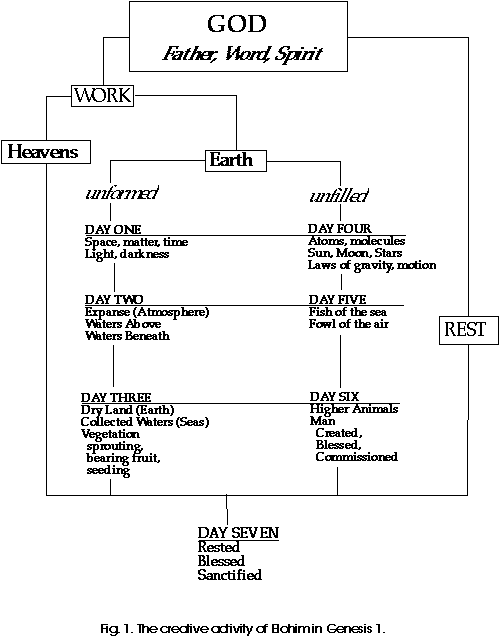
Evidently God did not create the universe in a single step, by one all-encompassing command, as Big Bang cosmology would infer. He created the universe, (visible and invisible), in a time period of six days. During this interval the usual laws of physics were not in effect. We should picture a big sign, UNDER CONSTRUCTION, posted on the job site where creation occurred to remind ourselves not to attempt to understand creation week by extrapolating present day laws and observations backwards from the present. This is one common error of uniformitarianism denounced by the Apostle Peter in his second epistle. The Laws of Physics were undefined until the clock was assembled and started running. The apparent start date was about 5800 BC. Before that, time was undefined!
Building a House If the universe is "God's house" as Scripture suggests, then creation week can perhaps be better understood by looking at how men build houses. One first selects a location for one's house. The plot of land is purchased and secured. The land is cleared. The architect draws up the plans. Contractors arrive and first the foundations are laid. Raw materials are brought to the job site (sand, concrete, lumber, nails, shingles, windows, bricks). Upon the foundation one builds the frame of the house, which at first resembles a shell. It is not at this time inhabitable, but the original formless materials have at least been given form and shape according to the architect's design.
The second stage of the building of the house is exterior landscaping and interior equipping and furnishing: carpets, drapes, appliances and furniture. Broadly speaking the first stage of construction is "forming" and the second stage is "filling." These two stages answer the original condition at the end of the First day of creation week when the universe was "tohu wabohu"-- unformed and unfilled. Human habitations consist of structures--which are assembled--plus an ecosystem and an environment. When both have been integrated together and completed, one has a complete house. The house can then be lived in and enjoyed.
|


 God is the observer in Genesis Chapter One, so we must take his
word for the order of events during creation week. For instance,
He tells us that the length of each of the six created modules,
or days, (yom) is what we now know as a standard 24 hour
day. That is, our present cycle of 7, 24-hour days per week is
stamped from the template of the seven days of creation. The clock
appointed by God to keeping time for us was not set in operation
until Day Four, however (Genesis 1:17,18). Dynamical time is determined
by the motion of the sun moon and stars, i.e., by Newton's Law
of Gravity and Kepler's Laws of motion. The clock run rate for
dynamical time was established by the fundamental design of the
physical universe. The other common scientific standard of time
measurement is atomic time. Dynamical time and atomic time were
originally locked in step with one another, but the Fall
has apparently brought about a slowing down of atomic time clocks
with respect to dynamical time. Time has other dimensions as well,
for instance there is a different flow of time in the spiritual
world. In short, time is actually multi-dimensional (even more
than Einstein suspected) and we poor fallen creatures are at present
very much trapped in a very restricted time frame. Our modern scientific speculations about creation week may be compared to a boy looking through a knot hole in the fence of an immense construction site.
God is the observer in Genesis Chapter One, so we must take his
word for the order of events during creation week. For instance,
He tells us that the length of each of the six created modules,
or days, (yom) is what we now know as a standard 24 hour
day. That is, our present cycle of 7, 24-hour days per week is
stamped from the template of the seven days of creation. The clock
appointed by God to keeping time for us was not set in operation
until Day Four, however (Genesis 1:17,18). Dynamical time is determined
by the motion of the sun moon and stars, i.e., by Newton's Law
of Gravity and Kepler's Laws of motion. The clock run rate for
dynamical time was established by the fundamental design of the
physical universe. The other common scientific standard of time
measurement is atomic time. Dynamical time and atomic time were
originally locked in step with one another, but the Fall
has apparently brought about a slowing down of atomic time clocks
with respect to dynamical time. Time has other dimensions as well,
for instance there is a different flow of time in the spiritual
world. In short, time is actually multi-dimensional (even more
than Einstein suspected) and we poor fallen creatures are at present
very much trapped in a very restricted time frame. Our modern scientific speculations about creation week may be compared to a boy looking through a knot hole in the fence of an immense construction site.Scripture actually suggests that the final solution concerning all the details of our universe's early history may elude us, (Ecclesiastes 3:11, Acts 1:7). Genesis does not give us a date for creation. One of the best arguments for a recent origin of the universe is the careful genealogical record the Bible gives us which connects the First Adam with the Last. It is impossible to move Adam into the distant past more than a few millennia before Jesus, the Second, or Last Adam, was born, without doing violence to the text of the Bible. However we can not dogmatically set an exact date for the creation because we do not have full information on discontinuities in physical laws occurring in the past. In addition the very nature of time itself as we perceive and measure it has been affected by the fall."For thus says the High and Lofty One Who inhabits eternity, whose name is Holy: 'I dwell in the high and holy place, With him who has a contrite and humble spirit, To revive the spirit of the humble, And to revive the heart of the contrite ones. For I will not contend forever, Nor will I always be angry; For the spirit would fail before Me, And the souls which I have made.'" (Isaiah 57:15-16)
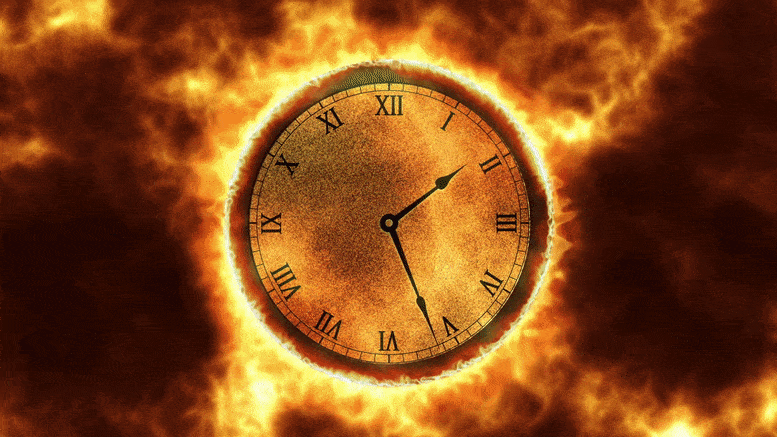 The warning to us from the Apostle Peter in his second epistle (3:3ff) tells us we must think of the ordinary,
present-day laws of physics as being inappropriate for describing creation week. An analogy might be the
construction of an aircraft. The aircraft, as a finished flying machine, can not be described until
it takes off on its maiden flight. After the designers' plans leave the drawing board,
aircraft components and modules--engines, fuselage sections, landing gear, seats,
instruments, etc.--are all ordered from subcontractors and brought to an assembly plant
where they are fitted together along an assembly line. Though we can understand each step of
the creative process our understanding of the aircraft as a unified system does not begin until the aircraft starts to fly.
The training and experience of the flight crew is another matter. Without them it's "no fly" for very expensive plane.
The warning to us from the Apostle Peter in his second epistle (3:3ff) tells us we must think of the ordinary,
present-day laws of physics as being inappropriate for describing creation week. An analogy might be the
construction of an aircraft. The aircraft, as a finished flying machine, can not be described until
it takes off on its maiden flight. After the designers' plans leave the drawing board,
aircraft components and modules--engines, fuselage sections, landing gear, seats,
instruments, etc.--are all ordered from subcontractors and brought to an assembly plant
where they are fitted together along an assembly line. Though we can understand each step of
the creative process our understanding of the aircraft as a unified system does not begin until the aircraft starts to fly.
The training and experience of the flight crew is another matter. Without them it's "no fly" for very expensive plane.
The Second Law of Thermodynamics states that "entropy
always increases" (in a fallen universe). Entropy measures
(1) the amount of available energy to do useful work, (2) the
degree of order in a system. Low entropy means lots of available
energy and a high degree of order and complexity. Prior to the
fall of the angels (who govern the universe under God), the Second
Law was evidently not in effect, i.e., the physical universe was
apparently not degenerative, or it was self-renewing. Apart from
God's intervention the present universe is running down and becoming
more and more disorderly. During the coming Millennial kingdom,
Jesus the Lord will evidently restore nature and probably reverse
the Second Law. It is always God who brings order out of chaos,
light out darkness, and life out of death.
Captions on the chart:
A. Day 1: Entropy is undefined before creation begins. To the left of the graph is "eternity past." God exists outside of time and space. There is no pre-existing matter.
B. Day 1: Space, time and matter are brought into existence. Entropy drops sharply because of large reservoir of energy capable of doing work is now in existence. This energy is in the form of rest mass, E=mc2.
C. Day 1: Light is created. Photons (perhaps of all wavelengths) imply that additional energy has now been added to the universe. Entropy drops further because of the creation of this new energy.
D. Day 2: The heavens are stretched out and attain their maximum diameter, which is the present diameter of the universe. A further addition of energy from God is involved, due to work done stretching the fabric of space. Entropy drops further.
E. Day 3: Genetic codes and living systems are created. This lowers the total entropy of the universe further because of the high degree of order, or information content in genetic codes. Random, simple molecules are assembled into highly-ordered structures by God as Artisan.
F. Day 4: The sun, moon and stars created. Energy created on Day 1 is concentrated. Amorphous matter also created on Day 1 is assembled into the heavenly bodies. The universe now has a higher degree of order, hence still lower entropy.
G. Day 6: The creation of man and the higher animals. Orderly living systems are built and programmed with "seeds" for replicating.
H. Day 7: God "rests," that is, He ceases from the work of creating and begins his work of sustaining the cosmos.
I. Day 7: The universe is now complete and entropy has its lowest value (maximum energy reserves plus highest degree of order). Since the entire universe is interlinked, it could not function as a working system until the end of Day 6. The finished universe now begins to function and history as we know it begins to be measured. The Biblical clock is established by the motion of the moon, earth and heavenly bodies.
J. Date Unknown (after creation week): The fall of the angels. The government of nature is disrupted. Angels play a prominent role in the management of the forces of nature during the age we now live in. The sin of man brings a "curse" on the earth further increasing the tendency of all things to rust, rot, wear out, and decay. Nature yields less bountifully. Thorns and thistles and opportunistic diseases increase.
K. The "Old" Creation is now "ruined" and hopelessly flawed. The Second Law of Thermodynamics is in effect, and from now on, "Entropy always increases." God's ultimate remedy will be the creation of "new heavens and a new earth."
L. The Flood of Noah. The rate of disorder and decay is probably accelerated at this time. Human life spans diminish after the Flood, for instance. The language of 2 Peter suggests the Flood affected the entire universe, not just the earth. The Flood was a major cataclysm as the Greek word suggests. The Hebrew mabbul suggests the same thing: an overwhelming disaster.
“Heaven is My throne,
And earth is My footstool.
Where is the house that you will build Me?
And where is the place of My rest?
For all those things My hand has made,
And all those things exist.”


The heavens are telling the glory of God; and the firmament proclaims
his handiwork.
Day to day pours forth speech, and night to night declares knowledge.
There is no speech, nor are there words; their voice is not heard;
yet their voice goes out through all the earth, and their words
to the end of the world.
In them he has set a tent for the sun,
which comes forth like a bridegroom leaving his chamber,
and like a strong man runs its course with joy.
Its rising is from the end of the heavens, and its circuit to
the end of them;
and there is nothing hid from its heat.
The law of the LORD is perfect, reviving the soul;
the testimony of the LORD is sure, making wise the simple;
the precepts of the LORD are right, rejoicing the heart;
the commandment of the LORD is pure, enlightening the eyes;
the fear of the LORD is clean, enduring for ever;
the ordinances of the LORD are true, and righteous altogether.
More to be desired are they than gold, even much fine gold;
sweeter also than honey and drippings of the honeycomb.
Moreover by them is thy servant warned;
in keeping them there is great reward.
But who can discern his errors? Clear thou me from hidden faults.
Keep back thy servant also from presumptuous sins; let them not
have dominion over me!
Then I shall be blameless, and innocent of great transgression.
Let the words of my mouth and the meditation of my heart be acceptable
in thy sight,
O LORD, my rock and my redeemer.
![]()
*bara, used only in referring to God in the Hebrew Bible occurs in Genesis 1:1, and in v21, 27.
God also "makes" (asah),
"causes to appear," (hayah),
"forms (yatsar),
"establishes" (kun), etc.
Man is "creative" only in that he carries the image of his Creator.
Only God can call into existence the things that do not exist (Romans 4:17, Amos 9:6, Psalm 33:6-8). See also Notes on the Early Chapters of Genesis.
1. James Stambaugh, Star Formation and Genesis 1, Impact #251, Institute of Creation Research, PO Box 2667, El Cajon, CA 92021, May 1994.
2. Davies, Paul, The Accidental Universe, Cambridge University Press, New York, 1982.
3. Misner, Charles W., Thorne, Kip S., and Wheeler, John Archibald, Gravitation, W. H. Freeman and Company, San Francisco, 1973.
4. Morton, Glenn R., Changing Constants and the Cosmos, CRSQ, Vol. 27, No. 2, September 1990, pp. 60-67
5. Norman, Trevor, and Setterfield, Barry, The Atomic Constants, Light and Time, SRI International Invited Research Report, August 1987. Other related papers and further technical information on this subject is available on this web page at On the Constancy of the Speed of Light.
6. Taking Genesis One seriously and literally poses lots of problems
for doing physics of the early universe. See Physics Problems for Creation Week
7. THE "DAYS" OF CREATION IN GENESIS 1:
LITERAL "DAYS" OR FIGURATIVE "PERIODS/EPOCHS" OF TIME? by Gerhard F. Hasel, late John Nevins Andrews Professor of
Old Testament and Biblical Theology, Andrews University, Berrien Springs, Michigan
8. The Observer's Location in Genesis One: The following notes show how Genesis One begins with a cosmic view of the entire universe, but soon narrows down to discuss the earth, the ecosystem, then man. This is in keeping with the overall constant, progressive narrowing of the Bible's focus onto the "scarlet thread" of man's redemption. (I am presenting here my current thoughts on this matter for discussion purposes. Others may not agree with me and I could change my mind at any time. Comments on this are welcome.)
9. The Music of the Spheres, (Musica universalis). Wikipedia.
Genesis 1:1 In the beginning God created the heavens and the earth. [Here the term "the heavens and earth" means the entire universe, physical plus the spiritual universe. The planet earth is not in view here]. 2 The earth [still refers to the entire material universe] was without form and void, and darkness was upon the face of the deep [tehom]; and the Spirit of God was moving over the face(s) of the [primeval, universal] waters. 3 And God said, "Let there be light"; and there was light. 4 And God saw that the light was good; and God separated the light from the darkness. 5 God called the light Day, and the darkness he called Night. And there was evening and there was morning, one day. 6 And God said, "Let there be a firmament in the midst of the waters, and let it separate the waters from the waters." [the discussion still refers to the whole universe--all of space everywhere] 7 And God made the firmament and separated the waters which were under the firmament from the waters which were above the firmament. And it was so. 8 And God called the firmament Heaven [shemayim, almost always plural in Hebrew]. And there was evening and there was morning, a second day [still referring to the entire universe not just the earth]. 9 And God said, "Let the waters under the heavens be gathered together into one place, and let the dry land appear." And it was so. 10 God called the dry land Earth, and the waters that were gathered together he called Seas. And God saw that it was good. [Here is the first mention of our planet, earth (eretz), as a created object within the cosmos. This is emphasized in the text by God's "naming" of Earth. "Naming" is the way God gives something its identity]. [From here on the focus of Genesis One is that of an observer on the planet earth. Things happening elsewhere in the universe are secondary and de-emphasized from this point on]. 11 And God said, "Let the earth put forth vegetation, plants yielding seed, and fruit trees bearing fruit in which is their seed, each according to its kind, upon the earth." And it was so. 12 The earth brought forth vegetation, plants yielding seed according to their own kinds, and trees bearing fruit in which is their seed, each according to its kind. And God saw that it was good. 13 And there was evening and there was morning, a third day. 14 And God said, "Let there be lights in the firmament of the heavens to separate the day from the night; and let them be for signs and for seasons and for days and years, 15 and let them be lights in the firmament of the heavens to give light upon the earth." And it was so. 16 And God made the two great lights, the greater light to rule the day, and the lesser light to rule the night; he made the stars also. [note the sun and moon are viewed here as more central to the narrative compared to the rest of the stars and planets, which are seen as incidental to the narrative, i.e., "he made the stars also," almost as if this were an afterthought].
17 And God set them in the firmament of the heavens to give light upon the earth, [earth the center of attention] 18 to rule over the day and over the night, and to separate the light from the darkness. And God saw that it was good. 19 And there was evening and there was morning, a fourth day. 20 And God said, "Let the waters [on earth] bring forth swarms of living creatures, and let birds fly above the earth across the firmament of the heavens." 21 So God created the great sea monsters and every living creature that moves, with which the waters swarm, according to their kinds, and every winged bird according to its kind. And God saw that it was good. 22 And God blessed them, saying, "Be fruitful and multiply and fill the waters in the seas, and let birds multiply on the earth." 23 And there was evening and there was morning, a fifth day. 24 And God said, "Let the earth bring forth living creatures according to their kinds: cattle and creeping things and beasts of the earth according to their kinds." And it was so. 25 And God made the beasts of the earth according to their kinds and the cattle according to their kinds, and everything that creeps upon the ground according to its kind. And God saw that it was good. 26 Then God said, "Let us make man in our image, after our likeness; [shift from nature to man] and let them have dominion over the fish of the sea, and over the birds of the air, and over the cattle, and over all the earth, and over every creeping thing that creeps upon the earth." 27 So God created man in his own image, in the image of God he created him; male and female he created them. 28 And God blessed them, and God said to them, "Be fruitful and multiply, and fill the earth and subdue it; and have dominion over the fish of the sea and over the birds of the air and over every living thing that moves upon the earth." 29 And God said, "Behold, I have given you every plant yielding seed which is upon the face of all the earth, and every tree with seed in its fruit; you shall have them for food. 30 And to every beast of the earth, and to every bird of the air, and to everything that creeps on the earth, everything that has the breath of life, I have given every green plant for food." And it was so. 31 And God saw everything that he had made, and behold, it was very good. And there was evening and there was morning, a sixth day..."
My Father's House
"The teaching of the New Testament is that now, at this very moment, there is a Man in heaven appearing in the presence of God for us. He is as certainly a man as was Adam or Moses or Paul; he is a man glorified, but his glorification did not de-humanize him. Today he is a real man, of the race of mankind, bearing our lineaments and dimensions, a visible and audible man, whom any other man would recognize instantly as one of us.
"But more than this, he is the heir of all things, Lord of all lords, head of the church, firstborn of the new creation. He is the way to God, the life of the believer, the hope of Israel, and the high priest of every true worshiper. He holds the keys of death and hell, and stands as advocate and surety for everyone who believes on him in truth. Salvation comes not by accepting the finished work, or deciding for Christ; it comes by believing on the Lord Jesus Christ, the whole, living, victorious Lord who, as God and man, fought our fight and won it, accepted our debt as his own and paid it, took our sins and died under them, and rose again to set us free. This is the true Christ; nothing less will do." (A.W. Tozer)
 lambert@ldolphin.org
lambert@ldolphin.org

Your Email is welcome
Lambert Dolphin's Place
900+ Recent and Recovered Articles. Free.
Newsletters Old and New
Index of Creation Articles
Articles on the Nature of Time